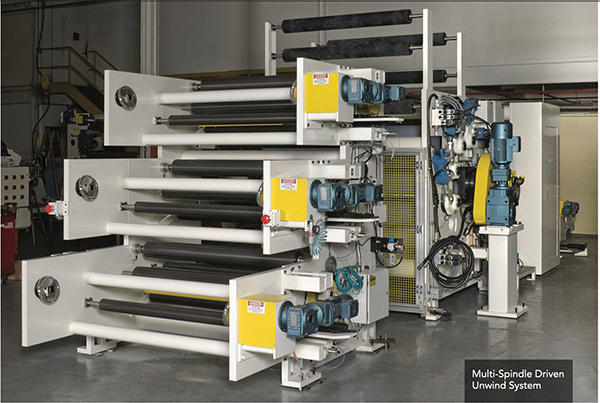Web Handling, Proper Tensioning & Guiding
- Published: November 16, 2023
By Bob Pasquale, President New Era Converting Machinery
A key requirement of every web processing line is the ability to properly handle and convey the web among the various machine sections. Though much time is typically spent focusing on the unwinding, winding, coating, drying, laminating and embossing sections, typically very little time is spent on the equipment sections that are required to allow for the proper handling and conveying of the web from section to section.
The proper handling and conveying of the web covers many areas including:
- Assuring that proper web tension is provided and maintained into, out of and between the various equipment sections;
- Assuring that the web is provided to the next section and removed from the previous section at the proper speed/rate;
- Assuring that the web is delivered to the next section at the required temperature.
Additionally, in certain web processing lines there is the need to change the orientation of the web, whether by:
- Turning it at right angles to the main web direction;
- Inverting it during processing.
In this issue and next, we will break into four major categories the equipment that is required for the above to occur: Pull Rolls, Heating and Cooling Rolls, Accumulators, Web Turns and Web Flips. For each of these equipment categories we will discuss the need for it, the uses of it, the factors and considerations that go into the design and selection of it, and the pros and cons associated with the selection.

Tension Control of the Unwinding Material
The two major areas to address regarding unwind tension control are the need for constant tension control and the method of generating the tension.
The Need for Constant Tension Control — On a center unwind, web tension is applied by using a device to impart a drag on the shaft/spindle that holds the web roll. This drag force results in a torque on the unwind roll.
The torque is related to web tension through the following formula: Torque = Force X Radius Where Force = the web tension and Radius = the radius of the unwinding roll. Therefore, in order to keep the web tension constant, the torque needs to be adjusted as the roll size changes.
Non-Constant Tension System = A system where no adjustments are made to the drag force, resulting in a system where the web tension varies as the unwind roll diameter changes. Advantages: Minimal cost, minimal maintenance. Disadvantages: Web tension varies as the unwind roll diameter changes.
Constant Tension System = A system where adjustments are made to the drag force as the unwind roll diameter changes, resulting in a constant web tension. This can be with no web feedback such as sonic sensor to measure the unwind roll diameter and adjust the drag force accordingly or with web feedback such as a force transducer or dancer to automatically maintain constant tension. Advantages: Allows for the web to be delivered to the process under constant tension. Disadvantages: Costly; requires extra space; higher maintenance.
The Method of Generating the Tension — One must decide on what type of device should be used to generate the web tension. Typically this is done through the use of either a brake or a motor/drive set. Braked System Advantages: Less costly to purchase, install and operate; easier to operate; minimal maintenance; pneumatic brakes are excellent for use in a hazardous environment. Disadvantages: Limited total tension range; may be difficult to use at low tensions; not good for use with damaged rolls; may not work well during roll acceleration where the acceleration force is greater than the required web tension; not good for applications where the web roll needs to be accelerated prior to unwinding.
Driven Unwind Motor/Drive System Advantages: Greater total tension range; good for use at low tensions; good for use with damaged rolls; works well during roll acceleration where the required acceleration force is greater than the web tension; good for applications where the web roll needs to be accelerated prior to unwinding Disadvantages: More costly to purchase and install, especially in a hazardous environment; higher maintenance; not good at low speeds, where reflected inertia is an issue.
Guiding of the Web as it Exits the Unwind
An important consideration is the need to guide the web as it exits the unwind. Though some unwinds are provided without the means of adjusting the web’s cross machine position, most include some form of adjustment, either as a manual or automatic system.
Manual System — A manual system is where either the roll of web or entire unwind is manually shifted in the cross machine direction. Advantages: Low cost; minimal maintenance. Disadvantages: No method for precision adjustment of the web location; no method for continuous adjustment.
Automatic System — An automatic system is one where the web location is continuously sensed and automatically corrected. This can be edge, line or center guiding and uses an actuating device to adjust the web’s position by moving the unwinding roll or entire unwind in the cross machine direction, or by pivoting a roll or pair of rolls that the web passes over upon exiting the unwind to steer it to the desired position.
Advantages: The web is automatically guided to a precise location; guiding of the web is continuous. Disadvantages: Higher cost of equipment; higher maintenance.
Next month we will continue the discussion, addressing splicing expiring rolls onto the new roll’s web, how the expiring roll’s web will be cut, number of unwind positions and roll-to-roll vs. continuous winding.
About the Author
Bob Pasquale is one of the founders and principals of New Era Converting Machinery, where he serves as President. He holds a degree in Mechanical Engineering from Stevens Institute of Technology and has worked in the web converting industry since 1985. He is the holder of several patents in the industry. Bob can be reached at bob. pasquale@neweraconverting.com.












